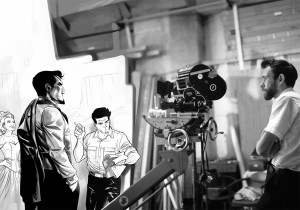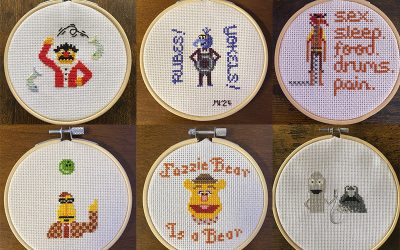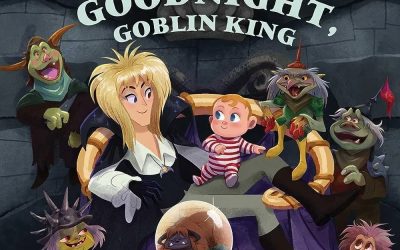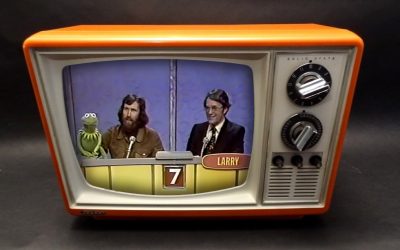One of the biggest surprises and most satisfying projects to come from The Jim Henson Company in recent years is, hands down, Tale of Sand. The graphic novel is an adaptation of a script written by Jim Henson and Jerry Juhl (hey, you know those guys!) way back in 1967, which they originally envisioned as a film. If you’ve read the book, you’d know that a film would be near impossible (although it would’ve been amazing to see Jim’s attempt), and it almost seems like it was always meant to be illustrated and bound in hardcover.
A project like this obviously needs another visionary to help transform the words into images, and the person who was most instrumental in bringing Tale of Sand to fruition was Ramón Pérez. Pérez not only illustrated the entire book, but he was responsible for translating Jim and Jerry’s script into a new medium. No simple task, I’m sure.
We caught up with Ramón and brought along lots of questions about how the book came to be. We also got a little tease of his new Farscape mini-comic, which is included in the new Blu-ray set of the series.
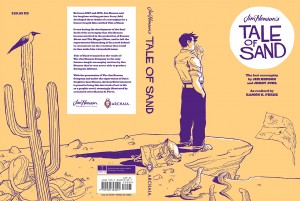 ToughPigs: How were you chosen as the artist to bring Jim Henson and Jerry Juhl’s Tale of Sand to life?
ToughPigs: How were you chosen as the artist to bring Jim Henson and Jerry Juhl’s Tale of Sand to life?
Ramón Pérez: I was contacted by then-Archaia assistant editor Chris Robinson. The company was approaching a variety of artists about potentially adapting the screenplay, and asking artists to do one or two sample pieces based on an excerpt of the script, to see how we might interpret it. I illustrated a pinup style image (which was eventually modified and used for the cover), as well as a sequential one; specifically I visualized the sequence showcasing Patch’s initial reveal after he emerges from the crater caused by the bomb thrown by Mac.
The sample pages submitted by the various artists were then submitted to the Henson Company, who upon viewing the art made their final choice as to who the artist would be. Luckily, both Lisa Henson, and the good people at Archaia, both agreed on me.
TP: What was it like bringing the work of the two greats – Jerry & Jim – to life?
RP: Adapting Tale Of Sand was a very fluid and natural process. I had begun visualizing elements of the story from the moment I first glanced upon the script. The whole process was rather fast and immersive, almost instinctual, due partially to the schedule of the book. It wasn’t till I handed in the final pages and the book was off to the printer that I really began to soak in the experience.
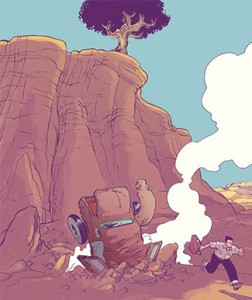 TP: Did you feel like you had to rewrite it to fit the graphic novel medium?
TP: Did you feel like you had to rewrite it to fit the graphic novel medium?
RP: Jim and Jerry’s screenplay was a fully realized one, but it was one that needed to be interpreted, digested, and readjusted to fit the graphic novel medium. I truly believe that the story of Tale Of Sand is somewhat of a Rorschach test, you could get a dozen different storytellers to interpret it and get a dozen different takes on the story. So in essence this is my interpretation of Tale Of Sand, what the story was to me. So yes, I did adjust and tweak the script in some areas to fit my interpretation and adaptation.
TP: Was it difficult to translate a story meant for the screen into graphic novel form? Can you describe the process of adapting the script?
RP: I gave the script a couple of read-throughs to absorb and digest it. To figure out what it meant to me. Actually, throughout the process of creating the book, I was constantly rereading the script and new elements constantly emerged; like peeling away the layers of an onion.
Once I had given the script a couple of thorough reads I proceeded to mark off natural page turns and moments. Pushed and pulled sequences to fit the graphic medium, as sometimes one line in the script would translate into five sequential pages, while convexly, 10 screenplay pages might translate into one page of the graphic novel. After laying out the book in this manner, I then sat down with the editors Stephen Christy and Chris Robinson to edit down the story in areas where we felt it dragged. Once we agreed on the final breakdown I dove into illustrating the book.
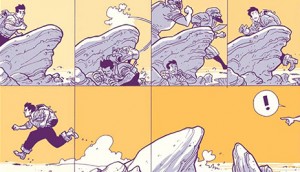 TP: How close to the original script did you stay? Did you make any small changes to put your own definition on it or to make the story more clear?
TP: How close to the original script did you stay? Did you make any small changes to put your own definition on it or to make the story more clear?
RP: I remained fairly faithful to the original. Though as I had mentioned, it is my interpretation of it, so i did adjust some elements to fit my perception of the story. Some sequences were shortened, while others cut completely; an extended car chance sequence and a poker game come to mind as the two major cuts in the story. Additional elements to suggest Mac was repeating his journey were added in, for example when he first entered the dilapidated bar. Within, there are elements of the fight that Mac is about to have; strewn about Arabian weapons; broken tables; and so forth, which were never in the original script.
TP: How long was the entire process, from beginning to end?
RP: Due to the release schedule, time constraints were quite tight. From beginning to end the process took about 5-6 months. With the first month being dedicated to adapting and laying out the story. Near the end, extra hands, i.e. background inkers, and extra colourists, were brought in to meet the overwhelming deadline.
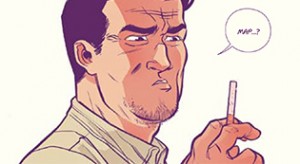 TP: The colors in the book are credited to you and Ian Herring, and they’re very striking. What did each of you contribute to that aspect of the book?
TP: The colors in the book are credited to you and Ian Herring, and they’re very striking. What did each of you contribute to that aspect of the book?
RP: Unable to colour the book on my own, due, once again, to the time parameters, we brought in a few colourists to meet my colour vision. Ian Herring tackled the lion’s share of the book, with Jordie Bellaire and Kalman Andrasofszky contributing to short sequences. Throughout the process I colour directed the entire look of the book, working especially close with Ian, who also brought his own fantastic colour sensibilities to the table, as well as colouring key pages myself, to maintain my personal vision of the book. The fact that Ian and I share a studio helped extensively with this collaborative process.
TP: Were there any sequences in the original script that you had to cut for length?
RP: Two to three major sequences were cut from the book, due to space as well as story fluidity. The first was a comedic poker game in the old tavern where Mac finds himself playing hide and seek from the football players and Arabs; the second was an extension of the huge car chase at the end of the book where the whole cast switched into Formula One race cars, and finally, a polo match in the middle of the desert. Some of these sequences caused the story to drag a bit, and while fun, didn’t really add much to the overall story, so a decision was made to cut them. There were a few other sequences that were truncated or re-edited as well, to help the story keep its staccato-like flow.
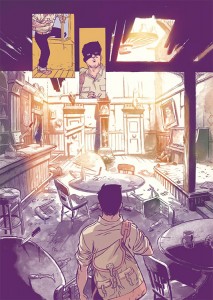 TP: The story is full of wild and crazy, imaginative sequences. Which part was the most fun to draw?
TP: The story is full of wild and crazy, imaginative sequences. Which part was the most fun to draw?
RP: Personal favourites of mine are the car chase, and the initial comedic chase sequence between Mac, the Arabs, and the football players. My personal favourite page is the one where Mac encounters a field of bear traps; I think this page particularly captures the tone and message of the book.
TP: Can you summarize what you think Tale of Sand is about? To the best of your ability?
RP: I think the beauty of Tale Of Sand is the story is, in essence, a Rorschach test of sorts. People will see what they want to see, or what is reflected in their own life.
Tale Of Sand, or rather my personal interpretation of it, is about life, essentially, and the goals we set for ourselves. We have a journey that we embark on (eagle mountain) of which we are unaware of for the most part, we set our own goals (Mac’s cigarette) that sometimes coincide with our journey, or are disparate from it. Throughout our journey we will encounter many obstacles that we will have to surmount. Some will be outside of ourselves—beyond our control, created by happenstance (the Arabs, the footballers), while others will come from, unknowingly, within us (Patch, The Blonde), and sometimes those very things are interrelated. Then you have our ego, playing with us, sometimes second guessing, even wanting us to fail, because we are afraid of our own success (Sven – the old drunk in the tavern.)
Then you have the avatars of Patch, who is who Mac wants to be, or thinks he wants to be: the playboy, the worldly man, an enigma, suave, mysterious, and debonair. Then you have the blonde, the woman we all want, looking for that love, that outside gratification to make us feel good about ourselves, but first we have to be comfortable in our own skin; love ourselves. Be happy with who we are.
This is Mac’s journey; it is everyone’s.
I think Tale Of Sand was Jim exploring his own questions about his life, and his career, what his goals were, or might have been. A young artist on the threshold of his career.
Or maybe this is all just me interpreting my own Rorschach test, correlating the story to my own life.
 TP: What do you think the ending (or beginning, I suppose) means?
TP: What do you think the ending (or beginning, I suppose) means?
RP: The ending to me, personally, signifies Mac’s failure in his quest. He’s trapped in a vicious circle, and can’t get out. He hasn’t found his true path, he’s close, but still lost.
TP: Was it a personal choice to weave the pages of Jim and Jerry’s script throughout the graphic novel?
RP: The idea of utilizing the pages came from Stephen Christy, the book’s primary editor. He had asked me to somehow weave in elements of the script as a tribute to the source material. Rather than just have the pages be a interesting graphic element, I really wanted to make them part of the story. Based on my interpretation of the story that I mentioned earlier—that Mac is trapped in his own vicious circle—I thought it would be fun to suggest that life was leaving him clues that he was missing. Literally, the writing on the wall, as in the opening sequence, where the script pages are poster bills on the street. Also, where we begin to see the other characters as the cast in Mac’s life, playing their roles: Patch’s script left behind on his sniper’s perch where he was gunning for Mac. In the original script, this was just a magazine.
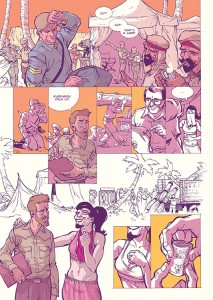 TP: Did you watch Jim Henson’s early works (like Time Piece and The Cube) as inspiration or research?
TP: Did you watch Jim Henson’s early works (like Time Piece and The Cube) as inspiration or research?
RP: Very much so. Time Piece especially, while The Cube I only skimmed. The latter I think tended to drag and was really representative of the era it was created in, while Time Piece I considered more a sister film to Tale Of Sand. Time Piece was definitely the catalyst for how I chose to visually interpret Tale Of Sand.
TP: Was the bit where Jerry and Jim make cameos already written into the script or was that your choice?
RP: That was my choice, a nod to both Jim and Jerry.
TP: How much of a Jim Henson fan were you before you got this gig? Has Henson or the Muppets influenced your other work in any way?
RP: I was a massive Jim Henson fan growing up, especially The Muppets. While I enjoyed his films The Dark Crystal and Labyrinth, it was The Muppets, as well as Sesame Street, that really seized my imagination as a child. I had a Muppet script book, with painted illustrations, that I cherished. Characters like Grover, Snuffleupagus, Oscar, Animal, and Rowlf, were mesmerizing, but Fozzie, he was my hero. I truly think The Muppets moulded my sense of humour to a certain degree, which I have carried over into my personal projects such as Butternutsquash.
TP: How closely did you work with the Henson Company people on the project?
RP: I enjoyed meeting Lisa Henson, and chatting with her about her father, as well as touring the Henson lot in LA. Though it was really Karen Falk, the Henson archivist, who shared with me Jim’s early works, including animated shorts, old notes, sketches, and storyboards for various projects, that truly allowed me to delve into Jim’s artistic sensibilities. It was Archaia editorial, in regards to approvals and feedback, who interacted with the Henson Company in the production of the book.
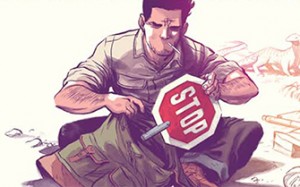 TP: What kind of feedback did the Henson folks give you as you were working on it?
TP: What kind of feedback did the Henson folks give you as you were working on it?
RP: Aside from a couple of notes to extend a sequence or two, I was given full creative freedom.
TP: What do you think Mac represents, as our everyman hero? Was he fully-realized in the script, or did you have to add to his personality?
RP: I think he is just that, the Everyman. He is the reader’s vessel as they read this Tarot card of a story, and correlate it to that of their own lives.
I spoke with a girl recently who had read Tale Of Sand, and she had mentioned her love of the story, and how cathartic it was for her. She had broke down in tears when she reached the ending and saw that Mac’s obstacles were his own—fabrications of himself. She, herself, was going through a very difficult time in her life, and when she saw this moment in the book she realized that a lot of the negative elements in her life that she thought were beyond her control, where actually being created by her.
The book literally changed her life. That is the beauty of Tale Of Sand.
TP: Does Mac smoke as much in the script as he does in the book? (In today’s Thank-You-For-Not-Smoking world, that part of the story stands out.)
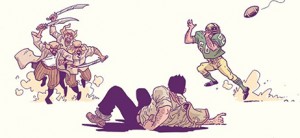 RP: As much as Mac wants to smoke in the story, he really only has one cigarette, which he finally gets to enjoy at the end. That being said, I think the cigarette is a metaphor for what we think we want in life, the false dream, immediate gratification. It’s why Mac is caught in his own loop.
RP: As much as Mac wants to smoke in the story, he really only has one cigarette, which he finally gets to enjoy at the end. That being said, I think the cigarette is a metaphor for what we think we want in life, the false dream, immediate gratification. It’s why Mac is caught in his own loop.
TP: Do you think Tale of Sand could ever be made into a movie?
RP: I think Tale Of Sand is very much a film of its era. I often compare it to The Beatles’ Yellow Submarine, and more so to The Monkees film Head. That said, I think it would be very difficult to make the film for today’s audience. However, if it were to be reworked, massaged a bit, while still maintaining the core idea, it could work for a modern audience.
TP: Are there any “Easter eggs” in the book that we may not have noticed yet?
RP: Yes. There is one in particular that I think sums up the story, which I haven’t noticed anyone publicly mention.
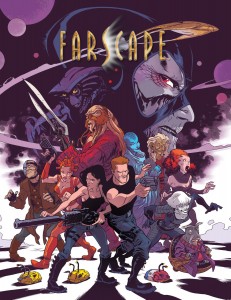 TP: We understand that you’ve contributed a short Farscape comic book to the recently released Blu-ray set. Can you give us a brief tease of what we can expect?
TP: We understand that you’ve contributed a short Farscape comic book to the recently released Blu-ray set. Can you give us a brief tease of what we can expect?
RP: I have been teasing both Archaia and The Henson Company since working on Tale Of Sand that if ever a Farscape project should arise, I wanted in. I have loved the series since it first aired, often thinking it the next Star Wars. So, when Stephen Christy called me up and said they were in need of a short Farscape story I quickly made room in my schedule.
The difficulty with the story was that I only had seven pages to work with. Because of this I wanted to come up with a fun little story that could be easily enjoyed, that echoed the feel of the TV series, and featured most of the characters. Yet the story itself couldn’t affect the characters in any lasting way as it is set within the era of the TV series. It’s my love note to Farscape.
TP: What sort of research did you do in preparation for the Farscape comic?
RP: I watched the series when it originally aired, so I was quite familiar with Farscape as a whole. But, when I was approached to do the short comic, I began rewatching the series to refresh myself with the cast of characters and their individual personalities and individual voices.
TP: Do you have a favorite Farscape character, either as a fan or as an artist?
RP: When I originally watched the series, from a visual standpoint, I loved the simple, yet unique, design of Chiana, and Gigi Edgley’s take on the character. But rewatching the series it really is Aeryn Sun that stands out to me, both Claudia Black’s beauty, and her character’s journey as a whole.
From an artistic standpoint while working on the short comic, it was Ka D’argo. As much as I loved the character in the TV series I always felt there was a visual awkwardness to his head (I know this sounds strange) that never sat quite right with me, so when drawing him for the comic, I visually reshaped his cranial proportions more to my liking.
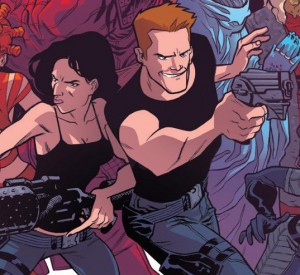 TP: How was it working on a second project with The Jim Henson Company? Were your interactions on this project similar to Tale of Sand?
TP: How was it working on a second project with The Jim Henson Company? Were your interactions on this project similar to Tale of Sand?
RP: Creating a Farscape short was a different kind of challenge. With Tale Of Sand, I was adapting an existing work and experimenting with the sequential medium to best service the story, while with Farscape I had to create a very short story, that took place within the Farscape story continuum that was true to the characters yet didn’t change them in any way. Wanting to keep exposition to a minimum due to the limited story space, I relied heavily on the audience’s familiarity with the characters. This is something, if given the chance, I would re-edit, adding a touch more dialogue to help the uninitiated enjoy the short.
TP: Have you seen any similarities between the worlds of Tale of Sand and Farscape? Do you see them as bookends to Jim Henson’s career and legacy?
RP: While both are from the Henson Company, they are of different eras and created by different people. One the father, and the other, by the son. While they are both about an individual’s journey, I think that is where the similarities end. I really don’t see them as bookends, but rather, Farscape, as denoting the next generation of The Henson Company, and its audience.
TP: Are there any other Henson or Muppet properties you’d like to work on?
RP: I think I would love to do a short story with the Muppets, adapt another potential Henson work from an old storyboard, or perhaps dabble in the world of Labyrinth, but most of all, I think, I would love to write and draw a long-form Farscape OGN, as seven pages was quite the tease!
TP: Finally, do you have a message you’d like to relay to the fans of your Henson work?
RP: Just a thank you. I have done shows the world over promoting Tale Of Sand, and the fans of the book, and Henson’s work, have been nothing short of fabulous.
I am honoured to be a part of the Henson legacy.
Many, many thanks to Ramón Pérez and Archaia’s Mel Caylo for all their help!
Click here to have to start all over again on the ToughPigs forum!
by Joe Hennes, Ryan Roe, and Julia Gaskill

